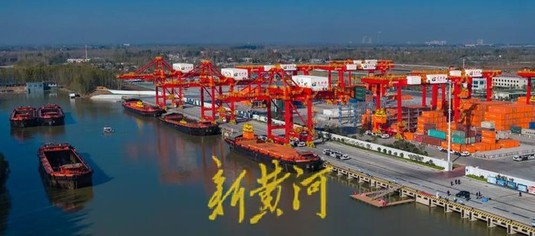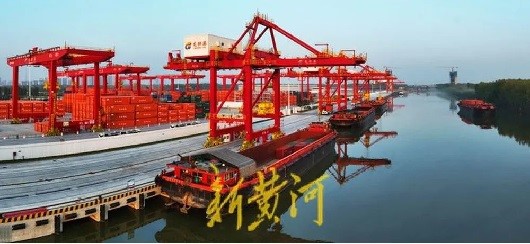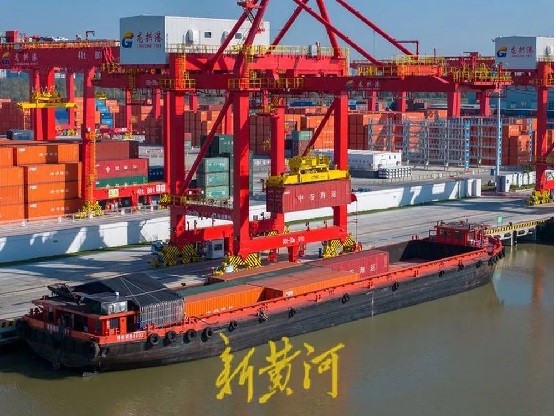Transforming the Beijing-Hangzhou Grand Canal (south of the Yellow River in Shandong Province) into a "golden waterway" efficiently connecting the southwestern Shandong region with the Yangtze River Delta is becoming a reality. Along the banks of the Longgong River, a smart container inland port-Longgong Port-is rapidly rising. On June 4th, at the on-site promotion meeting for key projects and rural revitalization in the province, the Longgong Port multimodal transportation industrial park project located in Jining was highlighted. As the largest-scale and most automated container inland port in northern China, Longgong Port is "activating" the Beijing-Hangzhou Grand Canal, serving as a "golden waterway." More companies are benefiting from water transportation, with some saving over 100 million yuan in shipping costs through Longgong Port last year.

From a small traditional bulk cargo port to the highest level of automation in northern China Three years ago, Longgong Port was just a small port with three traditional bulk cargo berths. Today, it is the first inland port in the country to achieve normalized operation of unmanned intelligent transportation and has established the province's first customs supervision site for inland waterway transportation, enabling foreign trade containers to clear customs "set sail" right at home. Speaking of this transformation, Zhang Guangyu, Party Secretary and Chairman of Jining Energy Group, told Xinhua News Agency that Longgong Port has introduced the concept of seaports into inland waterways. By utilizing advanced technologies such as 5G, Beidou navigation, laser guidance, and digital twins, it has broken through key technologies for automated inland ports, achieved full-process automation, and realized normalized operation, leading the way in the field of inland port automation at the international level.

Under such technological empowerment, Longgong Port's efficiency has increased by 30% compared to traditional methods. With the accelerated progress of the Longgong Port multimodal transportation industrial park project, the throughput capacity of this inland port continues to grow. As a major project in Shandong Province in 2022, the Longgong Port multimodal transportation industrial park project, with a total investment of 5.7 billion yuan, covers an area of 86.8 hectares and plans to build 18 berths with a capacity of 2,000 tons each, 9.4 kilometers of dedicated railway lines, and supporting container automated unmanned yards and multimodal transportation industrial parks. "The first phase of 10 berths was put into operation in September 2023, with a throughput capacity of 400,000 TEUs. The dedicated railway line will be completed and opened to traffic this June. We will start the second phase of the project in 2026. After the project is completed, the annual container throughput will reach 800,000 TEUs and the cargo throughput will exceed 30 million tons," Zhang Guangyu told Xinhua News Agency. Today, Longgong Port has become the largest-scale and most automated container inland port in northern China, playing an increasingly prominent role in inland water transportation.

The role of the "golden waterway" is highlighted, benefiting a carbon enterprise by saving transportation costs of over 100 million yuan From a geographical perspective, Longgong Port is located at the center of the "three horizontal and one vertical" logistics channel composed of the Wara Railway, Xinxi Railway, Yangtze River, and Beijing-Hangzhou Grand Canal. It connects to the west with the Belt and Road Initiative, to the east with Qingdao Port and Rizhao Port, and to the south with the Yangtze River and the Yangtze River Delta region. The rapid development of this port contributes to the realization of connectivity between rivers and seas, radiation throughout the country, and connectivity with Eurasia. Its rapid rise can be described as revitalizing the Beijing-Hangzhou Grand Canal, the "golden waterway." "Longgong Port is currently the largest container inland port in northern Jiangsu Province. It is not only beneficial for the development of Jining City but also for the surrounding areas within a radius of 500 kilometers in Shandong Province, Hebei Province, and Henan Province. In the past, some containers in the surrounding areas were transported to Rizhao Port by road or railway and then exported. Others were transported directly by road. Different transportation methods have different costs. The cost of road transportation is about 40 cents per ton-kilometer, railway transportation is about 20 cents, and water transportation is about 5 cents, so the cost of water transportation for containers is relatively low and more environmentally friendly," Zhang Guangyu told Xinhua News Agency. The construction of the Longgong Port project has greatly promoted the reduction of logistics costs for manufacturing companies in the surrounding areas.
Huqin Group, a tire manufacturing enterprise around Longgong Port, used to mainly rely on road transportation for tire transportation. With the improvement of Longgong Port's transportation capabilities, the company now transports tires through container transportation via this port. "A container can carry 260 tires. Compared with the previous transportation method, if shipped to Shanghai, the shipping cost for one tire can be saved by 13 yuan. With one container able to carry 260 tires, considerable cost savings can be achieved," Zhang Guangyu said. Many enterprises have benefited from the rise of Longgong Port. For example, a carbon factory in Jining used to transport bulk cargo, but after switching to container transportation via Longgong Port, transportation costs were reduced by over 100 million yuan last year. Aluminum products from Hebei's Hansteel and Liaocheng Xinfu are also transported through this port.
"Hansteel used to transport steel coils by truck, with one truck only able to carry one large steel coil weighing 30 tons. At Longgong Port, one ship can transport 100 steel coils for the company, totaling 3,000 tons, equivalent to the capacity of 100 trucks. Overall, compared with truck transportation to Changzhou, water transportation can save 30-50 yuan per ton for the company," Zhang Guangyu told Xinhua News Agency. In general, water transportation can save more than one-third of costs compared to other transportation methods, which is conducive to improving the competitiveness of manufacturing companies.
From statistical data, since 2022, Longgong Port has accumulated a container throughput of 218,000 TEUs and opened 24 routes through the "road to water" and "rail to water" multimodal transportation modes. Today, 400 containers are shipped from Longgong Port every day.

